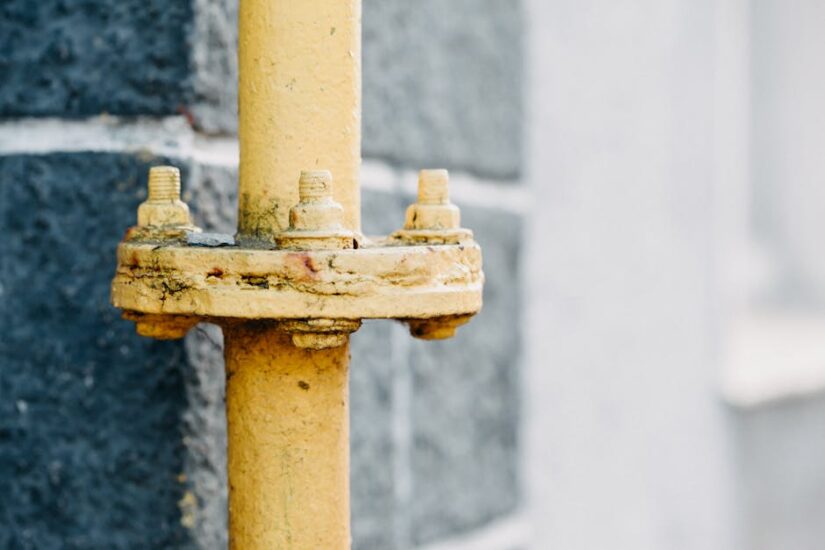Out with the Old: A Guide to Gas Pipe Replacement
By Brian on April 10, 2025

Why Gas Pipe Replacement is Essential for Safety and Efficiency
Gas pipe replacement is crucial for maintaining safety and efficiency in your home or business. If you’re dealing with outdated or damaged gas pipes, taking proactive steps is important. Here’s why:
- Old pipes can cause dangerous leaks.
- New appliances may need updated connections.
- Regular updates ensure compliance with safety regulations.
- Modern materials offer better performance and durability.
Gas pipe systems deliver natural gas to your appliances, offering an efficient energy solution. However, neglecting regular maintenance or replacement could lead to serious risks, including gas leaks, which can result in asphyxiation or explosions. Therefore, understanding when and why to replace your gas pipes is not only about efficiency but also about safeguarding your home and loved ones.
Whether you’re facing a leak, upgrading your system, or simply ensuring everything is up to code, knowing the signs that replacement is necessary can prevent costly repairs and protect against health hazards. This guide will walk you through the essential aspects of gas pipe replacement, emphasizing the importance of licensed professionals handling such tasks to ensure compliance and safety.

Understanding Gas Pipe Systems
Gas pipe systems are the invisible highways that transport natural gas from municipal lines or propane from storage tanks directly to your home appliances. These systems play a crucial role in making sure that your stove, oven, water heater, and heating system run smoothly and efficiently.
Natural Gas: The Energy Workhorse
Natural gas is a popular energy choice for many households due to its cost-effectiveness and efficiency. It’s used for heating, cooking, and hot water, providing a reliable and steady energy source. In fact, approximately 74 million homes in the U.S. use gas for these purposes.
How Gas Pipe Systems Work
Gas pipe systems consist of a series of pipes and valves that safely deliver gas to various appliances. These systems need to be installed correctly to ensure safety and efficiency. Proper installation and maintenance are key to preventing leaks and ensuring that your appliances work as they should.
Efficient Energy Use
Using natural gas is not only efficient but also environmentally friendly compared to some other energy sources. Modern gas pipe systems are designed to minimize energy loss, ensuring that the gas reaches your appliances with minimal waste. This efficiency translates to lower energy bills and a reduced carbon footprint.
Appliance Connection
When connecting new appliances, ensure that the gas lines are correctly sized and installed. This step is crucial for optimal performance and safety. Inadequate connections can lead to leaks or inefficient appliance operation.

Safety First
Safety is a top priority when dealing with gas pipe systems. Regular inspections and maintenance are necessary to identify potential issues before they become serious problems. If you notice any signs of a leak, such as a hissing sound or a higher-than-normal gas bill, it’s crucial to act swiftly.
Understanding your gas pipe system is the first step in ensuring your home’s energy needs are met safely and efficiently. In the next section, we’ll explore when gas pipe replacement becomes necessary and how to identify the signs that it’s time for an upgrade.
When Gas Pipe Replacement is Necessary
Gas pipe replacement is a critical part of maintaining a safe and efficient home. There are several situations where replacing gas pipes becomes necessary. Let’s break them down:
1. New Appliances
Whenever you install new gas-powered appliances, like a stove or water heater, it’s crucial to ensure the existing gas lines can handle the demand. New appliances might require different gas line specifications or locations, necessitating a gas pipe replacement to ensure safe and efficient operation.
2. Home Renovations
Planning a home renovation? If your remodel involves moving or adding rooms, you might need to reroute or extend your gas lines. This is especially true if you’re adding a new kitchen or bathroom. Properly installed and routed gas lines are essential to accommodate your home’s new layout and to maintain safety standards.
3. Aging Infrastructure
Older gas pipes can become corroded or damaged over time, leading to potential leaks or failures. If your home has aging gas infrastructure, it might be time to consider a replacement to ensure the safety and reliability of your gas system.
4. Compliance with Safety Codes
Building codes and safety standards evolve. If your gas lines were installed many years ago, they might not comply with current regulations. Updating your gas pipes to meet these standards is not just about compliance—it’s about ensuring the safety of your home and family. Compliance might involve upgrading to newer materials or technologies that offer improved safety features.
In each of these scenarios, consult with professionals who can assess your specific needs and ensure that your gas lines are safe and up to code. Keeping your gas system updated and well-maintained is crucial for both safety and efficiency. In the next section, we’ll dig into the Gas Pipe Replacement Process and what you need to know to get started.
Gas Pipe Replacement Process
Replacing a gas pipe is not just about swapping out old for new. It’s a detailed process that ensures safety and compliance. Here’s a step-by-step guide to what this process entails:
Permit Acquisition
Before any work starts, you need the right permits from your local authorities. Why? Permits ensure that your project follows building codes and safety standards. Without them, you could face fines or even have to redo the work.
Line Location
Next, it’s crucial to plan the route for the new gas line. This involves locating existing lines and plotting the safest and most efficient path for the new one. The goal is to minimize disruption and avoid other utilities. A professional can help you assess the landscape and determine the best route.
Sizing the Line
Proper line sizing is key. This means calculating the total BTU requirements of all connected appliances to ensure the line can deliver enough gas. An undersized line can lead to performance issues, while an oversized one is wasteful.
Choosing Materials
Selecting the right materials for your gas line is vital for safety and durability. Options include different types of metal or plastic pipes. Each has its pros and cons, and a professional can help you choose what’s best for your situation and local codes.
Installation
The installation phase involves extending the piping from the main line to where it’s needed. This step requires precision to prevent leaks. Safety protocols must be strictly followed to ensure a secure setup.
Leak Testing
Once installed, the entire system undergoes leak testing. This involves using specialized equipment to check for leaks and ensure everything is sealed tight. Leak testing is a critical step to prevent potential hazards.
Professional Inspection
Finally, a professional inspection verifies that the installation meets all local codes and standards. A certified inspector or utility representative typically performs this inspection. It’s the final checkpoint to ensure everything is safe and compliant.
These steps are essential to a successful gas pipe replacement. Each stage requires careful planning and execution to ensure safety and efficiency. In the next section, we’ll explore the Factors Influencing Gas Pipe Replacement Costs and what you should consider when budgeting for your project.
Factors Influencing Gas Pipe Replacement Costs
When planning for a gas pipe replacement, understanding the cost factors can help you budget effectively. Here’s what impacts the overall expense:
Length and Complexity
The length of the gas line plays a significant role in determining costs. Longer lines require more materials and labor, naturally driving up expenses. Complexity adds another layer—installations that involve obstacles or require special fittings can increase labor time and expertise, further raising costs.
Material Selection
The type of materials chosen for the gas piping affects both the initial cost and long-term durability. Common materials include polyethylene, steel, black iron, and copper. Each material has different price points and installation complexities. For instance, polyethylene is generally cheaper and easier to install, while steel may offer greater durability but at a higher cost.
Permitting and Inspection Fees
Don’t overlook permitting and inspection fees. These are necessary to ensure compliance with local building codes and safety standards. Fees can vary widely depending on your jurisdiction. In some areas, complex projects may require multiple permits or inspections, adding to the overall cost.
Geographic Location
Where you live can significantly influence your gas pipe replacement costs. Labor rates vary by region, with urban areas typically costing more than rural ones. Additionally, local regulations might impose specific requirements that can affect the total expense.

Understanding these factors can help you plan and manage your budget for a gas pipe replacement. In the next section, we’ll address some common questions about the costs associated with replacing gas pipes.
Frequently Asked Questions about Gas Pipe Replacement
How much does it cost to replace a gas pipe?
The cost of gas pipe replacement can vary significantly depending on several factors. Geographic location is a major influence. In urban areas like Sacramento, CA, labor costs tend to be higher than in more rural parts of Northern California.
On average, homeowners might expect to pay anywhere from $500 to several thousand dollars. The length of the pipe, the complexity of the installation, and the materials used will all impact the final bill. It’s always a good idea to get multiple estimates to ensure you’re getting a fair price.
Should rusty gas pipe be replaced?
Yes, rusty gas pipes should be replaced. Rust can weaken pipes, increasing the risk of leaks, which pose serious safety hazards. Regular inspections can help identify rust early. If you notice any signs of rust, it’s crucial to contact a professional immediately to assess and replace the affected sections.
Safety should always be the top priority. A small investment in replacing rusty pipes can prevent much larger problems down the line.
How often should gas pipes be replaced?
The lifespan of gas pipes can vary based on the material and environmental conditions. Generally, steel pipes can last 50 to 70 years, while polyethylene pipes might last 30 to 50 years. However, regular inspections are essential to ensure safety and efficiency.
It’s recommended to have a professional inspect your gas pipes every few years. This helps catch any issues early and ensures your gas line system remains safe and functional. If your home has older pipes or if you’ve noticed any issues, it might be time to consider a gas pipe replacement.
Regular maintenance and timely replacements can help avoid costly repairs and ensure your home remains safe. In the next section, we’ll conclude with how Go Pro Plumbing can assist with all your gas pipe needs.
Conclusion
At Go Pro Plumbing, we understand that gas pipe replacement is not just about maintaining your home’s energy efficiency—it’s about ensuring safety and peace of mind. Our commitment to outstanding customer service and same-day service sets us apart in Northern California.
Safety First: Safety is our top priority. Rusty or leaking gas pipes can pose significant risks, including gas leaks and potential explosions. That’s why our team of licensed professionals conducts thorough inspections and uses high-quality materials to ensure your gas line system is secure and efficient.
Professional Service: Our expert plumbers are trained to handle all aspects of gas pipe replacement, from obtaining necessary permits to conducting leak tests and inspections. We aim to make the process as seamless as possible, providing you with clear communication and timely updates throughout the project.
Whether you’re dealing with aging infrastructure or expanding your home with new gas-powered appliances, Go Pro Plumbing is here to help. Our expertise and dedication to quality workmanship ensure that your gas line system is in the best hands.
For more information or to schedule a service, visit our Gas Line Repair page. Let us help you keep your home safe and efficient with our professional gas pipe services.
